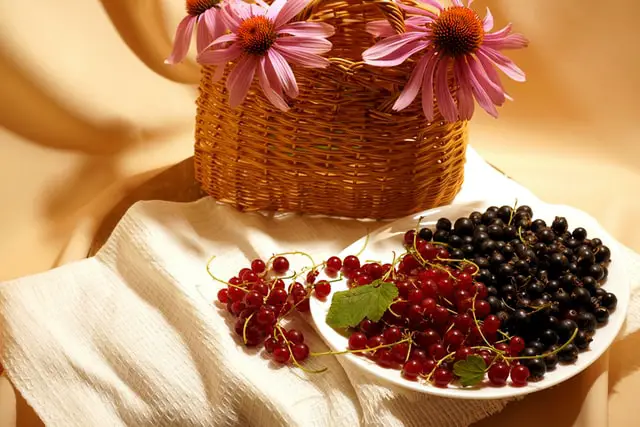Blackcurrant bushes do not require much care and attention, making them a popular UK garden choice. Better still, if you are short on space or only have a balcony, you can grow your blackcurrants in containers.

Blackcurrants can have a rather tart taste which makes them well suited to pies, tarts, jams, sauces, and cakes. The fruit can also be bottled or frozen. They are also full of healthy vitamins, providing a well-needed boost to your immune system. You can see up to 15lbs of fruit produced on your bush in one season.
Blackcurrants are native to Northern Europe and Asia but manage well with the UK temperatures. They are closely related to the redcurrant bush which grows under similar conditions. You can find wild blackberries, also known as Ribes nigrum, in damp areas such as woodland and near water. They are easy to identify by the black berries and drooping spiky-shaped yellow/green flowers.
Jump To...
Growing Blackcurrant Bushes
Flowering occurs on blackcurrant bushes in the spring months and fruit can be harvested in the summer. You can expect to see fruit in your bush’s second year and your bush will grow up to around 1.5 metres tall. Although a vigorous plant that grows well under its own steam, blackcurrant bushes do need to be tended to throughout the year.
When To Plant Blackcurrants
Your blackcurrant bush can be planted anytime between November and March when the ground isn’t hard. Container grown bushes can theoretically be planted anytime of the year if you can move away when frosts approach.
Where To Plant Blackcurrant Bushes
Once you’ve selected your chosen site for your bush, you should remove all weeds from this area. They will enjoy as much sun as possible but can also tolerate some shade. It is also best to buy your bare-root stock from a reputable buyer so you know you are purchasing good quality.
How To Plant Blackcurrant Bushes
Adding lots of manure to your primed area before planting will really benefit your bush. All soil should be well-drained but be moist at the same time. When planting bare-root stock, ensure your hole is twice the diameter of the root and be sure to spread the roots out.
Growing Blackcurrant Bushes in Pots
A container should be 45cm to 50cm in diameter and must have drainage holes. You should aim to repot your blackcurrant bush every two years so it doesn’t outgrow its location. The hole for a container-grown bush should be the same size as the root ball.
Blackcurrant Supports & Trellises
Some blackcurrant bushes will benefit from extra support, especially if they are a more vigorous variety. Below are the most commonly used in UK gardens.
- Train along a wall or fence – this is particularly handy if you have either in your garden and it’s in a suitable (sunny) position.
- Plant near a trellis – your blackcurrants will benefit from the extra support and they will look pretty during the flowering and fruiting process.
- Instead of a pot, you can use a deep container such as a barrel – this will offer additional support and look quirky too.
FAQ’s about Blackcurrants
Just to be sure we leave no stone untouched, here are our carefully selected FAQS on all things blackcurrant for your growing pleasure!
Blackcurrants are self-fertile meaning you only need to plant one bush to get a decent fruit yield.
Blackcurrants have clusters of pale green and yellow flowers that will be visible in the spring.
You can harvest blackcurrants during the summer months.
Blackcurrant bushes should be pruned during the dormant season. Pruning should involve removing old wood as the fruit develops best on new, young wood. During its first four years, you should aim to remove weak shoots – keeping to 6 to 10 in each area. After four years your bush will benefit from having some of the base (up to one third) chopped off to allow new, healthy growth.

